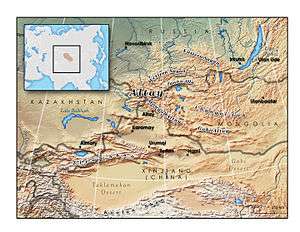Battle of the Altai Mountains
The Battle of Altai Mountains (Chinese: 稽落山之戰), was a major expedition launched against the Northern Xiongnu by the Han Dynasty in June 89 CE. The battle was a success for the Han under Dou Xian (d. 92 CE).[2][3][4]
In June 89 CE, the Han dispatched a force which promptly advanced from Jilu, Manyi, and Guyang in three great columns that included their allies, specifically the main army of the Southern Xiongnu.[2][3][4] The force of General Dou Xian advanced towards the Northern Chanyu into the Altai Mountains.[5] A large detachment then moved to the northwest, and in the major battle of the campaign they defeated the Northern Chanyu at the Altai Mountains and pursued them westwards.[2][3][4] The Han forces killed 13,000 Xiongnu troops and accepted the surrender of 200,000 Xiongnu from 81 tribes.[5]
Dou Xian brought the main body of his troops in triumphal progress north to the Khangai Mountains, west of present-day Kharkhorin. There he carved the cliff Inscriptions of Yanran,[6] composed by his client, the historian Ban Gu, which celebrated the achievement of the battle.[2][3][4] This inscription was identified in Dundgovi Province by scholars from Mongolia and China in August 2017.
Aftermath
After the successful campaign of 89 CE, the Xiongnu state was destroyed.[7] After the battle, Dou Xian led his forces back, and the Northern Chanyu sought to negotiate peace. Tuntuhe Chanyu of the Southern Xiongnu, however, was anxious to destroy his rival completely, and early in 90 CE, as embassies were still being exchanged, Dou Xian launched an attack, captured his rival's seal and treasure and his wives and daughters.[2][8]
General Dou Xian soon initiated a punitive expedition against the remaining hostile Xiongnu tribes, subsequently causing the tribes to flee westward.[9] Dou Xian had reported that the Northern Chanyu was so weak there was no point in treating with him further. In February 91 CE, he mounted a final invasion, with two of his generals Geng Kui and Ren Shang in charge. They advanced from Juyan and defeated the chanyu, captured his mother and killed 5,000 of his armies, drove him in flight again to the west from Altayn Nuruu. He was not heard of again.[2][8] The rest of the Xiongnu left in Dzungaria,[10] specifically near Lake Barkol, had not been directly affected, and some part of the shattered polity was reconstructed under a new chanyu. The new chanyu, however, was killed in 93 CE, and after him no chanyu of the Northern Xiongnu was ever heard of again.[11] On the frontier of China which faced present day Mongolia, the hostile Xiongnu state was ended.[2][8]
References
- Graff 2002, p. 40.
- Book of Later Han, vols. 04, 19, 23, 88, 89, 90.
- Zizhi Tongjian, vol. 47.
- An Tian, "Dou Xian Po Beixiongnu Zhi Zhan" ("The Battle of Dou Xian's Defeating on the Northern Xiongnu").
- Yü (1986), 415; Crespigny (2007), 171.
- 《封燕然山铭》辞曰:铄王师兮征荒裔,剿凶虐兮截海外,夐其邈兮亘地界,封神丘兮建隆嵑,熙帝载兮振万世 Inscriptions of Yanran.
- Lewis (2007), 138.
- Zizhi Tongjian, vols. 47, 48 (for modern annotation on location see Bo Yang's Edition of Zhi Tongjian).
- Tucker et al. (2010), 142.
- After the defeat in 91 AD, the shanyu left some 200,000 of his retired veterans and wounded settle at the Dzungaria under his younger brother and later the Prince Huyan, they would continue to be mentioned in annals until 151, when they raided Yiwulu and nearly wrested away from the Han but were driven off by the Governor of Dunhuang, Ma Da, eventually they moved northwest to the steppe of Kazakhstan and became known as the tribes of Yueban in later annals. The bravest and strongest of the Xiongnu migrated westwards under the shanyu in advance. Book of Later Han, vols. 88, 89 and Zizhi Tongjian, vol. 53.
- Though there was a rebellion by Xiongnu of the north elected a chanyu named Fenghou in 94, but he was of a Southern Xiongnu's royal house (son of Tuntuhe) and soon due to intimidation from the Xianbei, he was forced to surrender to the Han court by 118. Book of Later Han, vol. 88 and Zizhi Tongjian, vols. 48, 50.
Bibliography
- Crespigny, Rafe de (2007). A biographical dictionary of later Han to the Three Kingdoms (23 - 220 AD). Leiden: Brill Publishers. ISBN 90-04-15605-4.
- Fan Ye et al., Hou Hanshu. Beijing: Zhonghua Shuju, 1965. ISBN 978-7-101-00306-2
- Lewis, Mark Edward (2007). The early Chinese empires: Qin and Han. Cambridge: Harvard University Press. ISBN 978-0-674-02477-9.
- Sima Guang, comp. Zizhi Tongjian. Beijing: Zhonghua Shuju, 1956. ISBN 978-7-101-00183-9
- Graff, David A. (2002). Medieval Chinese Warfare, 300 – 900. London, New York City: Routledge. ISBN 0-415-23955-9.CS1 maint: ref=harv (link)
- Tucker, Spencer C. et al. (2010). A global chronology of conflict: From the ancient world to the modern Middle East. Santa Barbara: ABC-CLIO ISBN 978-1-85109-667-1.
- An, Tian, "Dou Xian Po Beixiongnu Zhi Zhan" ("The Battle of Dou Xian's Defeating on the Northern Xiongnu"). Encyclopedia of China, 1st ed.
- Yü, Ying-shih (1986). "Han foreign relations". The Cambridge History of China: Volume I: the Ch'in and Han empires, 221 B.C. - A.D. 220. Cambridge: Cambridge University Press. ISBN 0-521-24327-0.
